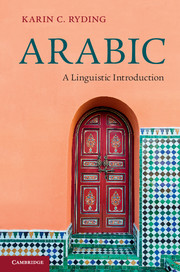Book contents
- Frontmatter
- Contents
- List of figures
- Preface
- Acknowledgments
- Abbreviations and symbols used in this book
- 1 Arabic linguistics: overview and history
- 2 Arabic phonology
- 3 Arabic phonotactics and morphophonology
- 4 Arabic syllable structure and stress
- 5 Introduction to Arabic morphology
- 6 Derivational morphology: the root/pattern system
- 7 Non-root/pattern morphology and the Arabic lexicon
- 8 Arabic inflectional morphology
- 9 Syntactic analysis and Arabic
- 10 Arabic syntax I: phrase structure
- 11 Arabic syntax II: clause structure
- Appendix A Fields of linguistics and Arabic
- Appendix B Arabic transcription/transliteration/romanization
- Appendix C Arabic nominal declensions
- Glossary of technical linguistic terms
- References
- Index
- References
References
Published online by Cambridge University Press: 05 June 2014
- Frontmatter
- Contents
- List of figures
- Preface
- Acknowledgments
- Abbreviations and symbols used in this book
- 1 Arabic linguistics: overview and history
- 2 Arabic phonology
- 3 Arabic phonotactics and morphophonology
- 4 Arabic syllable structure and stress
- 5 Introduction to Arabic morphology
- 6 Derivational morphology: the root/pattern system
- 7 Non-root/pattern morphology and the Arabic lexicon
- 8 Arabic inflectional morphology
- 9 Syntactic analysis and Arabic
- 10 Arabic syntax I: phrase structure
- 11 Arabic syntax II: clause structure
- Appendix A Fields of linguistics and Arabic
- Appendix B Arabic transcription/transliteration/romanization
- Appendix C Arabic nominal declensions
- Glossary of technical linguistic terms
- References
- Index
- References
- Type
- Chapter
- Information
- ArabicA Linguistic Introduction, pp. 167 - 180Publisher: Cambridge University PressPrint publication year: 2014



